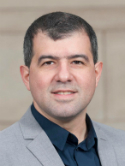GRASPNET: Fast spatiotemporal deep learning reconstruction of golden-angle radial data for free-breathing dynamic contrast-enhanced magnetic resonance imaging Journal Article
| Authors: | Jafari, R.; Do, R. K. G.; LaGratta, M. D.; Fung, M.; Bayram, E.; Cashen, T.; Otazo, R. |
| Article Title: | GRASPNET: Fast spatiotemporal deep learning reconstruction of golden-angle radial data for free-breathing dynamic contrast-enhanced magnetic resonance imaging |
| Abstract: | The purpose of the current study was to develop a deep learning technique called Golden-angle RAdial Sparse Parallel Network (GRASPnet) for fast reconstruction of dynamic contrast-enhanced 4D MRI acquired with golden-angle radial k-space trajectories. GRASPnet operates in the image-time space and does not use explicit data consistency to minimize the reconstruction time. Three different network architectures were developed: (1) GRASPnet-2D: 2D convolutional kernels (x,y) and coil and contrast dimensions collapsed into a single combined dimension; (2) GRASPnet-3D: 3D kernels (x,y,t); and (3) GRASPnet-2D + time: two 3D kernels to first exploit spatial correlations (x,y,1) followed by temporal correlations (1,1,t). The networks were trained using iterative GRASP reconstruction as the reference. Free-breathing 3D abdominal imaging with contrast injection was performed on 33 patients with liver lesions using a T1-weighted golden-angle stack-of-stars pulse sequence. Ten datasets were used for testing. The three GRASPnet architectures were compared with iterative GRASP results using quantitative and qualitative analysis, including impressions from two body radiologists. The three GRASPnet techniques reduced the reconstruction time to about 13 s with similar results with respect to iterative GRASP. Among the GRASPnet techniques, GRASPnet-2D + time compared favorably in the quantitative analysis. Spatiotemporal deep learning enables reconstruction of dynamic 4D contrast-enhanced images in a few seconds, which would facilitate translation to clinical practice of compressed sensing methods that are currently limited by long reconstruction times. © 2022 John Wiley & Sons Ltd. |
| Keywords: | adult; clinical article; controlled study; treatment response; nuclear magnetic resonance imaging; magnetic resonance imaging; clinical practice; image interpretation, computer-assisted; clinical study; algorithm; computer assisted diagnosis; image enhancement; quantitative analysis; contrast enhancement; imaging, three-dimensional; contrast medium; contrast media; artifact; respiration; dynamic contrast-enhanced magnetic resonance imaging; artifacts; dynamic contrast-enhanced mri; national health organization; image reconstruction; breathing pattern; qualitative analysis; architecture; breathing; procedures; three-dimensional imaging; fourier transform; dynamic contrast enhanced mri; humans; human; male; female; article; iterative methods; radial; free breathing; spatiotemporal analysis; deep learning; convolutional neural network; network architecture; reconstruction algorithm; 'current; data consistency; four-dimensional imaging; dynamic contrast enhanced imaging; golden angle; network techniques; parallel network; radial datum; golden angle radial sparse parallel network |
| Journal Title: | NMR in Biomedicine |
| Volume: | 36 |
| Issue: | 3 |
| ISSN: | 0952-3480 |
| Publisher: | John Wiley & Sons |
| Date Published: | 2023-03-01 |
| Start Page: | e4861 |
| Language: | English |
| DOI: | 10.1002/nbm.4861 |
| PUBMED: | 36305619 |
| PROVIDER: | scopus |
| PMCID: | PMC9898111 |
| DOI/URL: | |
| Notes: | The MSK Cancer Center Support Grant (P30 CA008748) is acknowledged in the PubMed record and PDF. Corresponding author is MSK author Ramin Jafari -- Export Date: 1 March 2023 -- Source: Scopus |
Altmetric
Citation Impact
BMJ Impact Analytics
MSK Authors
-
 261
261Do -
 4
4Fung -
 6
6LaGratta -
 51
51Otazo Torres -
 3
3Jafari
Related MSK Work



